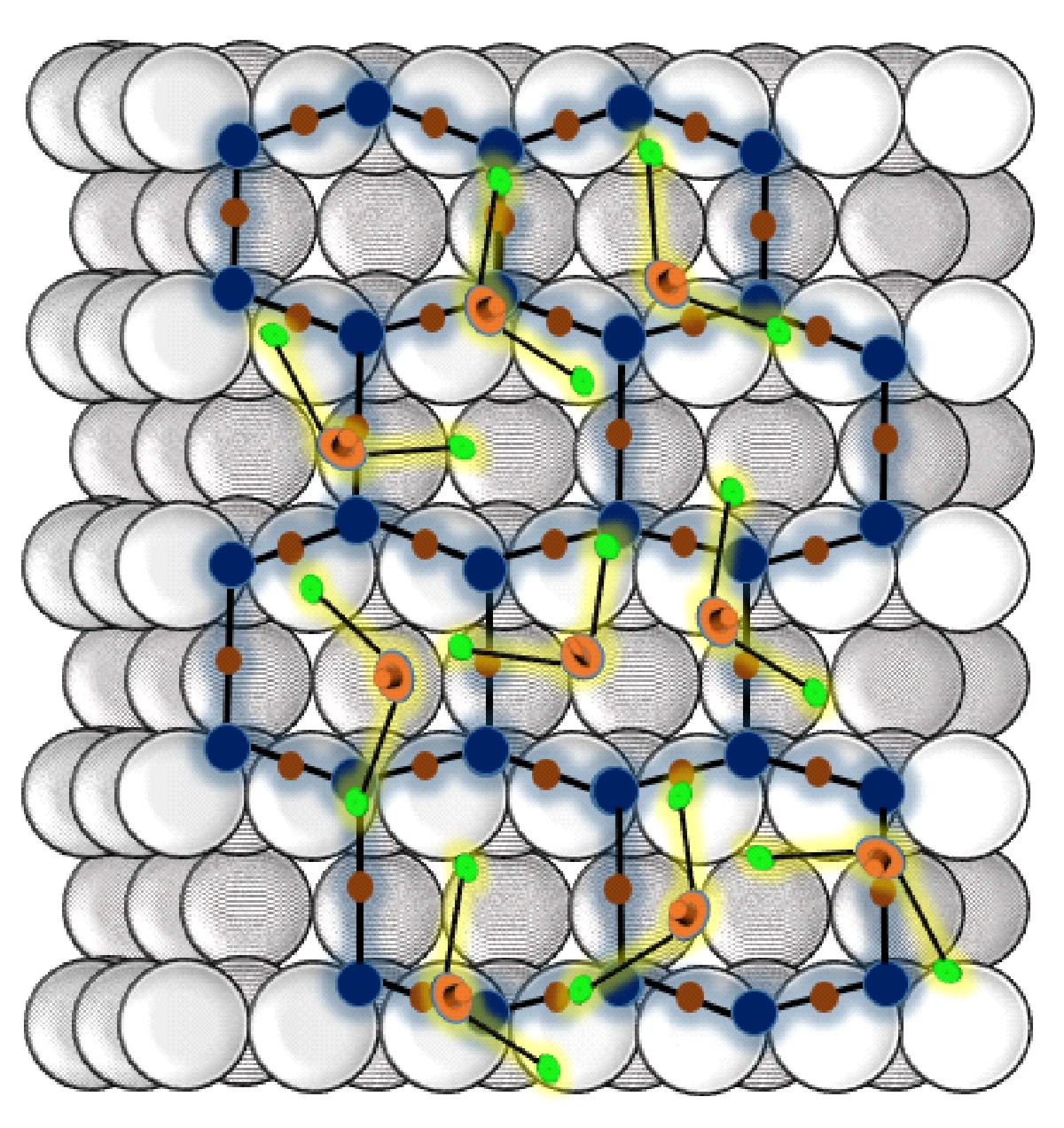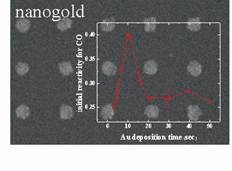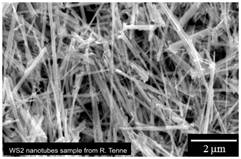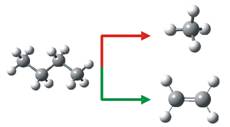Research Examples
What would you learn in our group...??
- You would learn to handle complex ultra high vacuum equipment which is key for many important technological processes.
- You would work with state of the art equipment such as a molecular beam system.
- Molecular beam scattering is a rather rare but very efficient experimental technique. A molecular beam might be compared with a LASER system, however, instead of monochromatic light we use supersonic and nearly monochromatic particle beams which allow us to sample the structure and reactivity of catalyst surfaces. That is, our research is quite close to industrial applications which are relevant for our daily lifes.
- Furthermore, we have a focus on nanoscience. and materials science.
![]()
Current project examples
![]()
Graphene: It turned out that small sulfur compounds dissociate on graphene epitaxially grown on ruthenium. This is one of the very few examples where clean and non-functionalized graphene is catalytically active. Some of the projects were conducted together with a theory group in Italy. We currently study surface chemistry of graphene deposited on non-metallic substrates for truly metal-free catalysis applications. Indeed, we found metal-free graphene based catalysts which could be commercialized.
Lead: T. Stach
New Lead: Md Arif Uddin, 2025-
Publications: e.g., J. Vac. Sci. Technol. A 41, 062201 (2023);
Collaboration: with a theory (DFT) group in Italy providing electronic structure modeling including Abdolvahab Seif, Alberto Ambrosetti, Pier Luigi Silvestrelli and recently a group in Belgium joint in, including TRUNG PHAM THANH, Robert Sporken working on synthesis.
![]()
Quasicrystals: Quasicrystalline surfaces have a long-range order, but no translational order, and, most importantly, they have a non-crystallographic point group symmetry. Literature would suggest promising chemical activity. We study fundamental surface science properties including adsorption kinetics and dynamics. Adsorption energies and activation energies will be determined by kinetics techniques (e.g., thermal desorption spectroscopy). The dynamics of e.g. the bond breaking mechanism will be studied by measuring adsorption probabilities using a molecular beam scattering system. The samples’ morphology will be characterized by low energy electron diffraction and XRD as well as chemical composition will be determined by Auger electron spectroscopy and X-ray photoelectron spectroscopy. Approximants will be considered to compare morphology effects and composition effects. Samples are available through an international collaboration with a group in Japan.
Lead: This is our most recent project.
Collaboration: with a materials science group in Japan synthesizing the crystals including
Farid Labib, Ryuji Tamura
![]()
Carbon Quantum dots: The future goal is developing antibacterial coatings (for e.g. packing materials) and water-based hand sanitizer which very well could be commercialized. The CQD product synthesis is water based and as a carbon-based system, CQD are sustainable. The functionalities of the Carbon Quantum Dots (CQD) from Lignin make the material antibacterial. Our part of this collaboration project is a spectroscopy characterization of those functionalities allowing for optimizing the material synthesis.
Collaboration: with several local groups in North Dakota who synthesize the material and run biological/medical tests including PI Mariia Goriacheva (Morrell), UND, Susan Eliazer, School of Medicine & Health Sciences, UND, Hilde van Gijssel, Valley City State University, Audrey LaVallie, Nueta Hidatsa Sahnish College
![]()
More examples (prior/past projects)
![]()
 Graphene. Water adsorption on CVD (chemical vapor deposition) graphene/SiO2 and graphene/Cu as well as PVD (physical vapor deposited) graphene/Ru(0001) were studied at clean ultra-high vacuum (UHV) conditions, focusing on support effects and hydrophobicity.
Graphene. Water adsorption on CVD (chemical vapor deposition) graphene/SiO2 and graphene/Cu as well as PVD (physical vapor deposited) graphene/Ru(0001) were studied at clean ultra-high vacuum (UHV) conditions, focusing on support effects and hydrophobicity.
Lead: Nilushni Sivapragasam (graduated 2019)
Publications: e.g. Chemical Communications 51 (2015) 11463; 50 (2014) 7698 [ List ]
![]()
 Silicatene. In the meanwhile several inorganic low-dimensional crystals (analog to the prototypical organic graphene) are known. A technological important example is two-dimensional (2D) silica films (silicatene); their molecular structure is well described in the literature. However, much less is known about the surface chemistry e.g. adsorption of gas-phase species on silicatene which we started to investigate.
Silicatene. In the meanwhile several inorganic low-dimensional crystals (analog to the prototypical organic graphene) are known. A technological important example is two-dimensional (2D) silica films (silicatene); their molecular structure is well described in the literature. However, much less is known about the surface chemistry e.g. adsorption of gas-phase species on silicatene which we started to investigate.
Lead: N.M.K.M. Tilan Abey (graduated 2019)
Supported by: ACS-PRF
Publications: e.g. J. Physical Chemistry C, 2018, 122, 8244–8253 [ list ]
![]()
 Model Catalysts - Nanoclusters on Supports: Here we focus our attention on the reactivity of metal nanoparticles which are deposited on metal oxide supports. These topics are related to heterogeneous catalysis and materials science applications. In collaboration with national laboratories, for some of these projects, nanofabrication techniques such as electron beam lithography are used to manufacture the samples. The figure shows a scanning electron microscopy image of a typical sample (made at Argonne National labs and Molecular Foundry in Chicago/Berkeley by S. Cabrini and L. Ocola) and molecular beam scattering data.
Model Catalysts - Nanoclusters on Supports: Here we focus our attention on the reactivity of metal nanoparticles which are deposited on metal oxide supports. These topics are related to heterogeneous catalysis and materials science applications. In collaboration with national laboratories, for some of these projects, nanofabrication techniques such as electron beam lithography are used to manufacture the samples. The figure shows a scanning electron microscopy image of a typical sample (made at Argonne National labs and Molecular Foundry in Chicago/Berkeley by S. Cabrini and L. Ocola) and molecular beam scattering data.
Lead: Dr. E . Kadossov
Publications: e.g. Chemical Physics Letters 483 (2009) 250-253
Supported by: NSF-CAREER
![]()

Nanotubes: We work with carbon nanotubes and inorganic nanotubes mostly towards application in heterogeneous catalysis. The figure shows a sample of WS2 nanotubes which are used for hydrodesulfurization catalysis. We obtained the sample shown here from R. Tenne (Weizmann Inst., Israel).
Lead: PhD project of Mallikharjuna Komarneni
Publications: e.g.,Catalysis Letters 129 (2009) 66-70; 125 (2008) 236-242; Chemical Physics Letters 476 (2009) 227-231
Supported by: DoE
![]()
 Alkaline Earth Oxides: Projects related to a DoE-EPSCoR state grant concern the reactivity of CaO, graphite, and iron oxide surfaces and related nanoclusters. Coal includes these compounds as impurities. Therefore we study the interaction of combustion gases with these systems.
Alkaline Earth Oxides: Projects related to a DoE-EPSCoR state grant concern the reactivity of CaO, graphite, and iron oxide surfaces and related nanoclusters. Coal includes these compounds as impurities. Therefore we study the interaction of combustion gases with these systems. Lead: Ashish Chakradhar's Ph.D. project
Publications: e.g. Chemical Communications (2008) 4073-4075
Supported by: DoE-EPSCoR
Trips: Graduate students will attend ACS meetings and may work off campus with collaboration partners at e.g. national labs.
![]()
